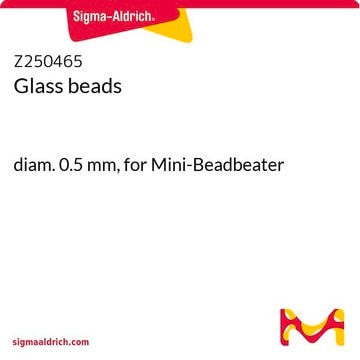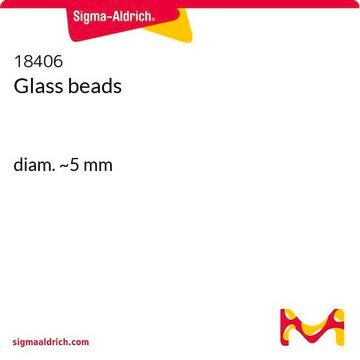G9268
Glass beads, unwashed
425-600 μm (30-40 U.S. sieve)
Synonym(s):
Glass beads
Sign Into View Organizational & Contract Pricing
All Photos(4)
About This Item
UNSPSC Code:
41100000
NACRES:
NB.22
Recommended Products
particle size
425-600 μm (30-40 U.S. sieve)
Application
Unwashedglass beads have been used:
- in the quantification of protein in fungal colonybiofilm
- in the lysis of microglial cells for the extraction andquantification of chlorophylls and cell mortality rate
- in the extraction ofDNA and RNA from microbial communities
Storage Class Code
11 - Combustible Solids
WGK
WGK 3
Flash Point(F)
Not applicable
Flash Point(C)
Not applicable
Personal Protective Equipment
dust mask type N95 (US), Eyeshields, Gloves
Certificates of Analysis (COA)
Search for Certificates of Analysis (COA) by entering the products Lot/Batch Number. Lot and Batch Numbers can be found on a product’s label following the words ‘Lot’ or ‘Batch’.
Already Own This Product?
Find documentation for the products that you have recently purchased in the Document Library.
Customers Also Viewed
Xavier Garcia-Ortega et al.
Frontiers in bioengineering and biotechnology, 3, 107-107 (2015-08-19)
The most commonly used cell disruption procedures may present lack of reproducibility, which introduces significant errors in the quantification of intracellular components. In this work, an approach consisting in the definition of an overall key performance indicator (KPI) was implemented
Ruoyun Li et al.
Journal of proteomics, 203, 103377-103377 (2019-05-19)
The molecular mechanism of Saccharomyces cerevisiae tolerant to ethanol stress remains to be further elucidated. In this study, a comprehensive analysis based on RNA-seq and iTRAQ LC-MS/MS was used to investigate the global mechanism of S. cerevisiae strain Sc131 in
Production of long chain omega-3 fatty acids and carotenoids in tropical areas by a new heat-tolerant microalga Tetraselmis sp. DS3
Hsin P T, et al.
Food Chemistry, 682-690 (2016)
Daniel R Leadbeater et al.
Microbiome, 9(1), 48-48 (2021-02-19)
Salt marshes are major natural repositories of sequestered organic carbon with high burial rates of organic matter, produced by highly productive native flora. Accumulated carbon predominantly exists as lignocellulose which is metabolised by communities of functionally diverse microbes. However, the
Zinc oxide nanoparticles hinder fungal biofilm development in an ancient Egyptian tomb
Gambino M, et al.
International Biodeterioration & Biodegradation, 122, 92-99 (2017)
Our team of scientists has experience in all areas of research including Life Science, Material Science, Chemical Synthesis, Chromatography, Analytical and many others.
Contact Technical Service











